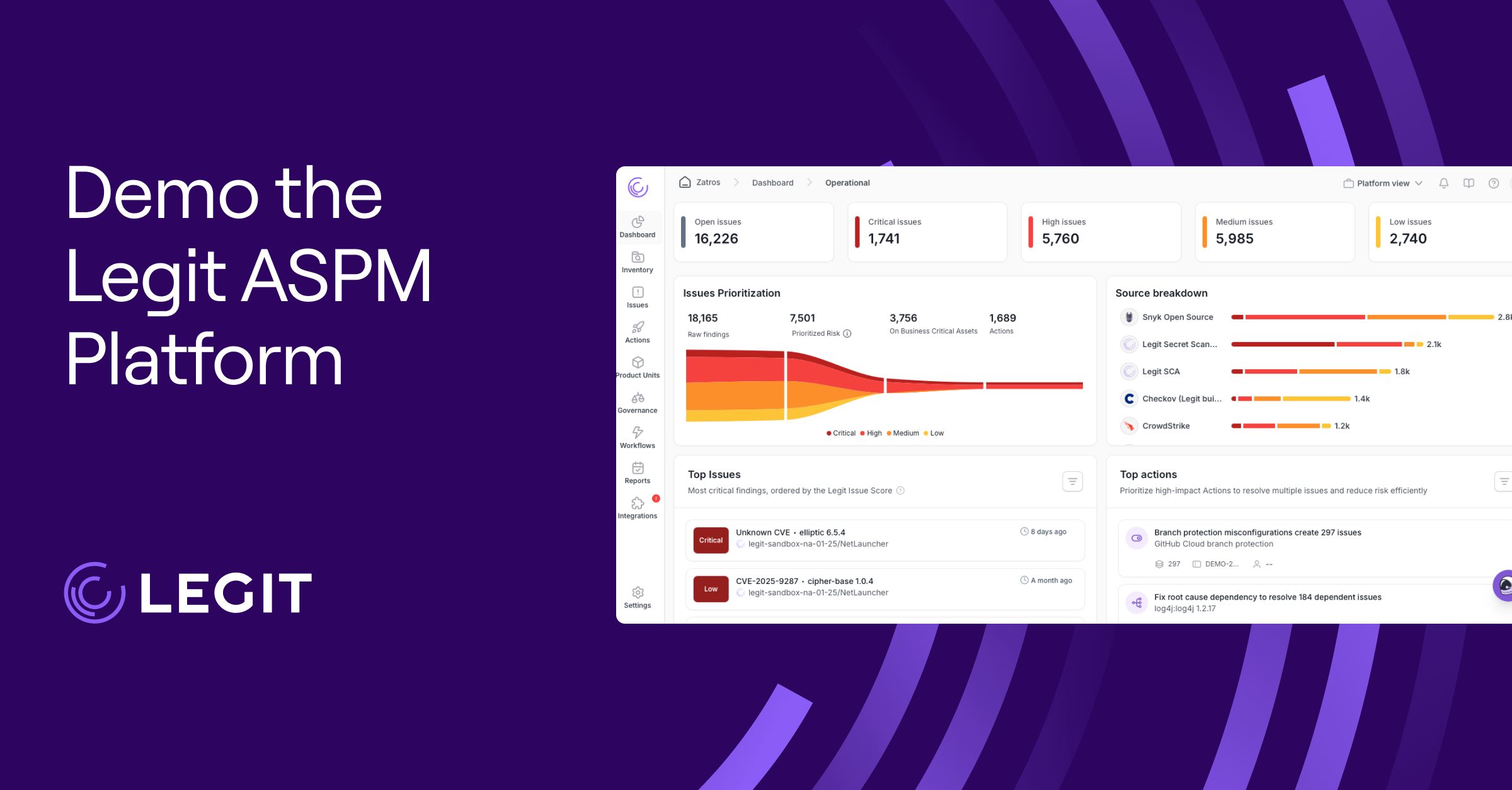The massive migration to the cloud that we’ve seen over the last decade or so has creating a critical and growing need for cybersecurity solutions to protect increasingly complex cloud application environments. Traditional security measures often fall short in addressing the unique challenges cloud infrastructures pose, especially when it comes to scaling and managing sensitive data. This is where Cloud-Native Application Protection Platforms (CNAPP) come into play, offering comprehensive and scalable solutions for cloud security.
This article delves into what CNAPP is and details its benefits, the challenges it addresses, and practical tips for scaling your cloud security processes. We'll explore how CNAPP not only enhances your security posture, but also how it aligns with organizational goals to provide a strategic advantage within software development.
Meet the Next Critical Layer of Cloud Security: CNAPP
A Cloud-Native Application Protection Platform (CNAPP), according to Microsoft, is an “all-in-one platform that unifies security and compliance capabilities to prevent, detect, and respond to cloud security threats.” It represents a new approach to cloud security that aims to alleviate some of the operational issues organizations have faced in trying to manage their cloud application security.
What does CNAPP do?
CNAPP looks to integrate previously siloed cloud security solutions into a single user interface to streamline the process of protecting an organization's entire cloud application environment. By consolidating various security tools, CNAPP provides a more cohesive and efficient approach to cloud security management.
The History of CNAPP
The term CNAPP was first coined by Gartner in 2021. The category emerged as a response to the growing complexity and diversity of cloud environments. As organizations increasingly adopted multi-cloud and hybrid cloud strategies, a corresponding integrated and comprehensive security solution was required. CNAPP emerged to address this need by offering a unified platform that covers a wide range of security and compliance functions.
Benefits of CNAPP
Most CNAPP solutions offer the following:
Multi-cloud Support: CNAPP provides robust support for multi-cloud environments, ensuring consistent security across different cloud platforms, helping to maintain cloud security capabilities as organizations scale and grow their cloud environments.
Centralized Control: With centralized control over compliance, permissions and visibility, organizations can better meet regulatory requirements and manage access controls more efficiently.
Shift Left Approach: CNAPP recommends a 'shift left' approach to software development security, encouraging developers to integrate security measures early in the application development process and remediate application vulnerabilities and other risk before being deployed to the cloud.
Simplifies Tool Stack Use: By integrating and centralizing various tools, CNAPP simplifies the security stack, eliminating redundancies and inefficiencies that can lead to alert fatigue, missed vulnerabilities, or accidental oversight.
Enhanced Contextual Insights: With their streamlined and centralized approach to cloud security, CNAPPs apply greater context to cloud security insights, simplifying the remediation process and improving response capabilities for addressing security incidents.
CNAPP is a crucial part of a secure software development process and allows companies to have more comprehensive overall security from code to cloud. CNAPPs alleviate the complexity burden many departments face when faced with multiple cloud solutions while also offering improved security capabilities with better insights.
Cloud Application Security Challenges CNAPP Addresses
CNAPP solutions are designed to help overcome many of the challenges organizations face when trying to address their cloud application security needs. This includes:
Scaling Workloads and Alert Fatigue: The rapid scaling of cloud workloads often leads to a surge in security alerts that can quickly overwhelm cybersecurity teams, potentially allowing threats to slip through. CNAPPs assist in managing and reducing alert volume, and prioritizing them in a centralized location, allowing cybersecurity security teams to more efficiently sift through alerts and address those that matter most.
Container Orchestration and Posture Management: With the rise of container orchestration, like Kubernetes, organizations have another component to manage and oversee. CNAPPs help centralize security efforts, minimizing the risk that an organization will lose track of containerized applications or leave them susceptible to attacks from a threat actor.
Tedious Agent Installation and Workload Hygiene: The process of installing security agents and applications on individual cloud workloads can be laborious and lead to increased operational complexity and overhead. CNAPPs streamline this process, enhancing workload manageability and reducing the chance of exposed risk due to an overburdened department.
Visibility Issues in Cloud Assets: The more complex and cloud environment, the bigger the risk that critical and/or sensitive assets are obscured or misplaced, leading to decreased visibility into how they are functioning and potential security risks. CNAPPs help address these visibility issues via centralized management, allowing departments to have better control over their assets across all cloud workspaces, ensuring comprehensive security coverage.
CSPM Integration Challenges: Cloud Security Posture Management (CSPM) solutions have been helpful for cloud security, but they don't always seamlessly integrate with other solutions. CNAPPs bridge this gap, providing a unified platform for managing various cloud security tools.
Alert Prioritization for Effective Remediation: Prioritizing alerts for timely remediation is a common challenge, given the disparate solutions involved, creating alerts with minimal context. By centralizing alert management CNAPPs offer contextual insights, which aid in the efficient and effective resolution of security issues.
By addressing these challenges, CNAPPs play a crucial role in enhancing cloud application security even further, addressing underlying issues that may make scaling cloud environments risky and difficult to manage. This gives organizations a more efficient way of tackling cloud security.
Tips to Streamline Your Cloud Security Processes When Scaling Up
Integrating CNAPP solutions into your security operations framework is an important step towards having a more robust cloud security strategy—but it’s important to make sure you’re doing so in an effective way to facilitate a robust and scalable security posture. Here are a few strategies that organizations should consider adopting.
Use CSPM & CNAPP in Tandem
When optimizing your cloud security, don’t think of CNAPP vs CSPM as a binary option to choose from. Instead, consider how they can work in synergy.
CNAPP offers a centralized approach to cloud-native application security while CSPM focuses on managing and improving the security posture of cloud environments. Utilizing CNAPP alongside CSPM allows for a more holistic and comprehensive security framework. CSPM's strengths in identifying misconfigurations and enforcing policy compliance complements CNAPP's ability to protect against threats throughout the entire cloud application lifecycle. This tandem approach ensures that as your cloud infrastructure scales, every aspect of your cloud application security posture is strengthened, from compliance to visibility to threat detection and response.
Consider Agentless Workload Scanning
Agentless workload scanning is a common feature found in CNAPP tools and offers a non-intrusive way to monitor and secure cloud workloads compared to traditional agent-based approaches. This method reduces the complexity and overhead associated with deploying and maintaining agents, which can become too burdensome in large-scale and multi-cloud environments. With agentless workload scanning, organizations can have more efficient and effective workload hygiene protection. This approach simplifies security management while enhancing overall security posture by providing real-time visibility into cloud workloads and freeing up time and space for more productive tasks.
Take an Application-Centric Approach to Security
Adopting an application-centric approach to security is crucial, particularly when utilizing CNAPPs or any cloud native security platform. This is a strategic shift that focuses on the security of applications, their components, and its underlying infrastructure. By taking this multifunctional, application-centric view, organizations can better understand the aggregate risk associated with an application across all its components and throughout the SDLC. This perspective allows for more targeted security measures, ensuring that all aspects of an application, from its code to its deployment environment, are secured. It’s particularly beneficial in complex cloud environments where applications are often dynamic and distributed, which require a more robust and comprehensive strategy for risk management.
Secure Your Cloud Applications with CNAPP
As complex cloud environments become the norm, organizations need to prioritize implementing cloud application security in an efficient enough way to manage the scope. Integrating CNAPP with CSPM and making it a key part of your cloud security infrastructure is an essential step in protecting sensitive data at scale. This synergy maximizes the coverage and efficiency of your security measures and allows you to have code-to-cloud security coverage in your SDLC.
CNAPPs also alleviate many of the vendor and visibility complexities associated with a complex cloud environment. This allows organizations to have a much more comprehensive cloud application security approach without compromising on developer and department resources.
The Legit Security ASPM platform was designed to help DevSecOps teams gain complete visibility into assets in their developer environments. This goes hand in hand with CNAPP solutions to deliver comprehensive cloud application security. Given the risk involved in the software supply chain, having a dedicated solution that comprehensively scans developer and application assets to identify risks and vulnerabilities can be a major asset towards having a secure software development environment.
To learn more about how Legit Security can help build a holistic, code-to-cloud secure application delivery strategy, Book a Demo to see the Legit Security platform in action.
Download our new whitepaper.


